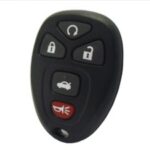Key fobs offer unparalleled convenience, allowing you to lock, unlock, and even start your car with a simple press of a button. However, what happens when your key fob suddenly stops working, or you need to program a new one? Understanding how to program your key fob to unlock your car doors is essential for every car owner. This guide will walk you through the basics of key fob programming, common issues, and when to seek professional help.
Key fobs use radio frequencies to communicate with your car’s computer system. This system, often involving a transponder chip within the key fob, verifies the key’s signal before allowing actions like unlocking doors or starting the engine. Programming essentially involves teaching your car to recognize the unique signal from your key fob.
Several situations might require you to program your key fob. If you replace a lost or damaged key fob, you’ll definitely need to program the new one to work with your car. Sometimes, even after battery replacement in your key fob, reprogramming might be necessary. In more complex scenarios, like replacing a car module or experiencing electrical issues, key fob programming can become a troubleshooting step.
While some vehicles allow for DIY key fob programming using specific sequences of button presses and ignition turns (often detailed in your owner’s manual), many modern cars require specialized equipment. Dealerships and qualified automotive locksmiths typically have the tools and expertise to handle more intricate programming needs.
If you’re facing issues where your key fob won’t unlock your car doors, consider these troubleshooting steps:
-
Check the Key Fob Battery: This is the simplest and most common fix. A dead battery will render your key fob useless. Replace it with the correct type and try again.
-
Consult Your Owner’s Manual: Your car’s manual is your best friend for DIY programming. Look for specific instructions for your make and model. Procedures vary significantly between manufacturers and even models within the same brand.
-
Ensure Correct Key Fob Compatibility: If you purchased a replacement key fob, verify it’s the correct one for your car’s make, model, and year. Using an incompatible key fob will prevent successful programming.
-
Consider Car Battery Issues: In some cases, a low car battery or electrical system problem can interfere with key fob programming. Ensure your car battery is healthy and properly charged.
Alt text: Car key and key fob on a neutral surface, showcasing typical components.
If DIY methods fail, or if you encounter complex issues like module replacements affecting key recognition, seeking professional help is advisable. Dealerships have factory diagnostic tools and access to vehicle-specific programming procedures. Automotive locksmiths often specialize in key and remote programming and can be a more cost-effective alternative to dealerships. They possess the necessary equipment to diagnose and resolve key fob programming problems, including situations where the car’s computer system is not communicating correctly with the key fob.
Alt text: Close-up of a car door lock mechanism, emphasizing security and access control.
In conclusion, understanding how to program your key fob to unlock car doors can save you time and frustration. While DIY programming is possible for some vehicles, complex situations often require professional expertise. By understanding the basics of key fob technology and troubleshooting steps, you can effectively address key fob issues and maintain the convenience and security of your vehicle’s remote access system. Always prioritize consulting your owner’s manual and seeking qualified professionals when needed to ensure proper and secure key fob programming.
Alt text: Technician programming a car key fob using diagnostic equipment, highlighting professional automotive service.
